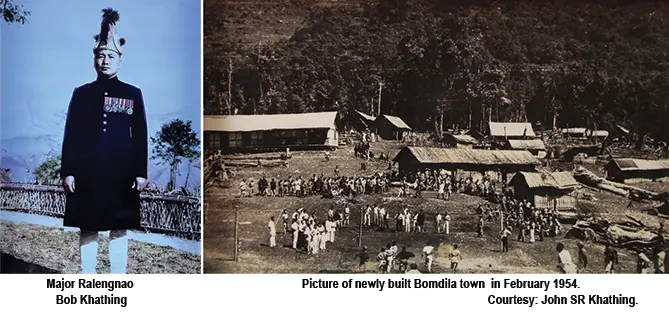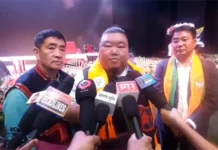[ Amar Sangno ]
ITANAGAR, 3 Nov: History has been really unkind to Major Ralengnao Bob Khathing’s enduring legacy and his role in integrating Tawang into the Indian Union, particularly as part of Arunachal Pradesh. Though Major Bob Khathing was one of the most decorated Army officers from the region during World War II and was awarded the Padma Shri in 1957, he remained a ‘forgotten hero,’ as did his legacy, until Chief Minister Pema Khandu’s government decided to acknowledge his exemplary services by building a museum in his name at Tawang on February 14, 2021, and awarded him the Arunachal Ratna (posthumously) in the same year.
Years after the foundation stone of the museum was laid by then-Governor Brigadier (Retd) B.D. Mishra, in the presence of Meghalaya Chief Minister Conrad Sangma, Chief Minister Pema Khandu, Union Minister Kiren Rijiju, and then-Chief of Defense Staff (CDS) General Bipin Rawat, the museum was inaugurated virtually by the Union Minister of Defense Rajnath Singh on Thursday.
The Bob Khathing Museum is built on a hillside near the Tawang War Memorial, sparsely covered with high-altitude spruce trees. The museum chronicles the life and achievements of the unsung hero, especially his reconnaissance to Tawang in February 1951. The museum was curated by Moji Riba, Assistant Professor in the Mass Communication department at Rajiv Gandhi University.
Born on February 28, 1912, in Ukhrul, Manipur, Major Bob was a Tangkhul Naga who did his schooling at Primary Ukhrul Mission School and graduated from Cotton College, Guwahati, in 1937. He was the first tribal man from Manipur to graduate until 1937.
“His nickname Bob originated from fellow Allied Force officers who were unable to pronounce Ralengnao properly and named him ‘Robert,’ which was later shortened to Bob and remained throughout his career and life,” writes John S.R. Khathing, the eldest son of Major Bob Khathing.
Unsung hero Major Bob Khathing was more than a political officer to NEFA; he was a tribal bridge to the newly independent Indian administration in NEFA.
In a moving account of his father’s administrative life, John Khathing, eldest son of Major Bob Khathing, who is a retired IRS officer, penned untold stories about his late father’s reconnaissance patrol to Rima (the Tibetan area alongside Kibhitu in Anjaw district) in the Lohit basin, his role in the restoration of roads and communication, and delivery of relief materials during the Assam Earthquake in August 1950, and, more importantly, the building of Bomdila, then headquarters of the Sela Sub Agency in 1954.
Major Bob, with half a section of the 2nd Assam Rifles and the 6 Kumaon Regiment under Major D.K. Roy and Captain B. Gupta of Brigade Intelligence, while on patrol in Rima, was caught in a powerful earthquake at Minzong Staging Camp, measuring 8.6 on the Richter scale, which was later known as the Assam Earthquake.
John further narrated that Major Bob Khathing, along with 20 jawans of the Assam Rifles and Kumaon Regiment with two officers, was stranded as Mishmi porters ran away to their villages. The group somehow managed to reach the Assam Rifles Platoon Outpost at Hayuliang. Only then could they contact Sadiya and Shillong to inform them that they were all safe.
“Major Bob later set about organizing a road restoration effort with his group. After two weeks of hard struggle, the Sadiya Road was somehow made passable. After opening better road communications to Sadiya and arranging proper relief measures for the villagers, the team left the Hayuliang Assam Rifles Outpost in the last week of September 1950 to report back to Battalion Headquarters at Sadiya,” writes John Khathing.
Bob was called to Shillong to give first-hand information on the extent of the damages to the Mishmi Hills. This was in the first week of October 1950. Upon submitting his report, he was appointed Assistant Political Officer of NEFA and posted at Pasighat in the Siang Frontier Division to supervise relief works in the Siang Frontier Division and Sadiya Division, with a base at Pasighat.
Bob was later called to Shillong in December 1950 and was directed to meet then-Governor Jairamdas Daulataram and was later tasked with the Tawang expedition. He started the expedition for Tawang on January 17, 1951, from the Lokhra Camp near Charduar, Assam, accompanied by Company Commander Captain Hem Bahadur Limbu, Subedar Akal Bahadur, Captain Monteiro of the AMC, and personal staff Shimrahei. He officially took Tawang under Indian administration by hoisting the Indian flag on February 09, 1951, ending the long-held abeyance of the 1914 Shimla Accord.
Major Bob not only brought Tawang into Indian administration but also appointed Gaon Buras in each village for effective local administration, in addition to the traditional pattern where there was only one Gaon Bura for each Tso (a group of three to ten villages).
French historian Claude Arpi, in his own words, said, “The Chinese Liberation Army arrived in Lhasa in September 1951, just a few months after Khathing had taken control over Tawang. One can imagine what would have happened if Khathing had not ‘liberated’ Tawang and the surrounding area in time.”
When Major Bob was promoted to take over from Maj. G.T. Allen, MC, as the political officer of the Sela Sub Agency in April 1952, the headquarters of the Political Officer, Sela Sub Agency, was then functioning from Charduar in the valley of Darrang district of Assam. In fact, all the headquarters of NEFA Divisions were operating from various valley locations in Assam.
The Government of India, however, directed that all NEFA headquarters of Political Officers be established in the interior hills. So Major Bob started searching for a suitable capital around the Monpa area, including Dirang Dzong, Miji (Sajolang), Sherdukpen, Rupa, Shergaon, Aka areas, and the Jamiri area-but finding a place was a difficult task. The search was conducted for about three weeks before Bob selected Bomdila to be the capital of the Sela Sub Agency.
John writes that there is a famous story about how his father Major Bob selected Bomdila as Sela Sub Agency headquarters. “To search for a suitable site in this thickly forested jungle area was very difficult. One fine day, he ‘disappeared’ for three days in the jungle. Major Bob used his guerrilla warfare experiences and instincts from the Second World War in the Burma jungle. Upon his return, he mentioned that he had found and selected the site for the capital. It is said he had gone into the jungle, saw a deer at some point, and followed the animal from a distance. He kept trailing the deer wherever it went. The deer reached a spot where water was available. Bob checked and marked the place for the area in his mind to be the location of the new capital. That’s how Bomdila was built as Sela Sub Agency Capital, which later became the headquarters of the Kameng sector.”
Bomdila was then a virgin forest, strictly nobody’s land, lying between the south of Rahung Monpa village, 20 miles away, and a Sherdukpen village in the south, 8 miles away. The nearest village was Wanghu, a village of the Khousas, about 4 miles southeast of Bomdila. Bob’s selection, however, was objected to by a few, as they thought it was uninhabitable because of the cold climate, thickness of the forest, and its location on a mountain range at around 9,000 ft. above sea level.
Despite these objections, Bob had the jungle clearing started with two sections of porters. By early 1954, the small township of Bomdila was ready for occupancy. In February 1954, the shifting of the Headquarters of the Political Officer from Charduar to Bomdila was undertaken, and on February 28, 1954, Bomdila was officially made the capital of the Sela Sub Agency.
A month thereafter, Bob handed over charge to Major P.N. Kaul, a new entrant to the Indian Frontier Administrative Service, as he was to take charge of the Tuensang Frontier Division as Political Officer, from Capt. R. Sailo.



